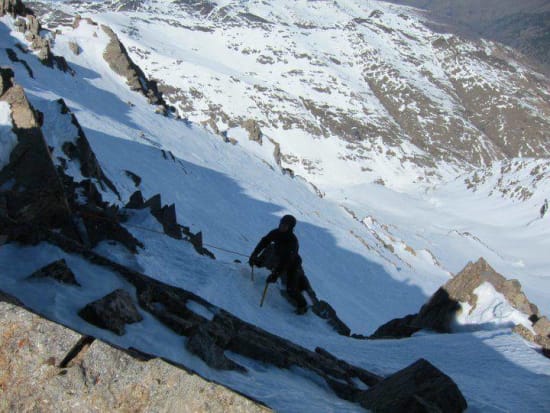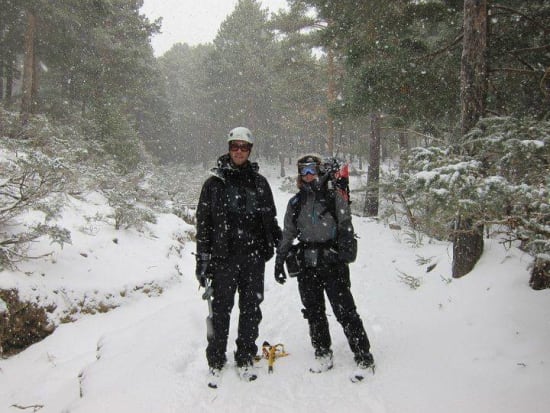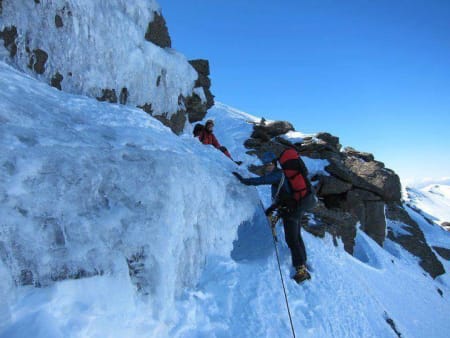Beth and Stephen from Leeds came to the Sierra Nevada with a clear idea of what they wanted to do: winter climbing and mountaineering. However, just after they arrived we met for a drink in Lanjaron: the sun was shining and it was 26C. Up in the mountains that meant the snow was melting fast, whilst the more sheltered North faces were still inaccessible to the high avalanche risk. So our first day climbing was spent in T-shirts rather than belay jackets as we went rock climbing instead.
Report from Jens Foell
All photos courtesy of Stephen and Bethany Lovell

On the Tajos de la Virgen ridge
As the weather forecast promised a marked drop in temperatures we went up to the Poqueira hut the next day. The night in the hut wasn’t that cold but as we approached the Caldera refuge the next morning a cold wind provided a chill of somewhere around -10C.
We climbed the beautiful ridge to the Puntal de Caldera, but with Stephen and Beth being experienced clients we also did some top roping on the North face and carried on past the summit; there a sudden drop of the ridge calls for slightly more demanding climbing. During the crux section on the Northern face we had strong, freezing-cold winds blasting icy snow in our faces! And just after coming off the ridge the clouds came in and we walked back to the hut in a total white-out.

North face of Puntal de la Caldera
After returning to Lanjaron the same day, followed by a rest day, temperatures had steadily dropped further (-16 above 3000m, according to the forecasts) so conditions were right for the next trip: we started with a morning of top-rope protected ice climbing at the Cascada de los Militares near the ski station and then went up to the Carihuela refuge, at 3200m the highest place to stay in the Sierra.
A massive cornice is currently blocking access from the Eastern side (i.e. from the Poqueira hut or Mulhacen), its edge being located just 5m from the front door of the refuge. But our objective lay to the South: crossing over the Sierra via the exposed Tajos de la Virgin ridge, a route that depending on conditions can be anything from an easy scramble to a Grade 3 winter climb.

Refugio Cebollar
We did find a lot of snow and ice on the ridge so both crux sections had to be overcome by fully protected, pitched climbing. Nobody had come this way since the last snow falls almost 2 weeks before, except for one creature: a big mountain cat’s paw prints lead the way (Lynx?), all the way along the ridge, with tiny yellow marks marking it’s territory every 100-200m.

Ice climbing Cascadas de los Militares
We were lucky with the weather. The morning had been mostly clear but in the afternoon the clouds came in. And although we’d spent a whole hour digging out the door of the Elorietta refuge we decided to continue along the ridge to the Pico del Tajo de los Machos and down to the Cebollar hut. That decision was less motivated by the incoming weather as by Beth’s feeling that the Elorietta, a former TB hospital and very dark and abandoned looking inside, had an ‘eerie’ feeling to it. And although this made the day a long one as we had to continue with our big packs, arriving at the Cebollar in yet another white out, it turned out to be a wise decision indeed.
The next morning not only the weather deteriorated further (strong snow falls and low visibility) but also Stephen’s health: he woke up with sciatica induced pains, his mobility impaired. So instead of doing some fun climbing on the Las Alegas peak we now had to worry about how to get us and all the gear safely down to Puente Palo.
And thanks to a group effort involving Kiersten and Andy from the Spanish Highs back up team we made it down allright: we just about managed to drive down to Lanjaron before the track became totally blocked by all the new snow. On arrival in town it even snowed there, not a common occurrence at 700m in March. And compare that to the hot, sunny weather a week earlier- in the Sierra Nevada you really can have 4 seasons packed into 1 week!

In the Alpujarras forests above Puente Palo
